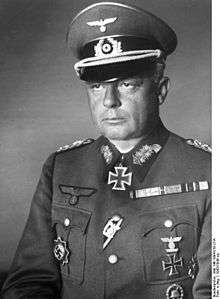Johannes Frießner
| Johannes (Hans) Friessner | |
|---|---|
 | |
| Born |
22 March 1892 Chemnitz, Kingdom of Saxony, German Empire |
| Died |
26 June 1971 (aged 79) Bad Reichenhall, Bavaria, West Germany |
| Allegiance |
|
| Service/branch |
Imperial German Army Reichswehr Wehrmacht |
| Years of service | 1911–1945 |
| Rank | Generaloberst |
| Commands held | XXIII. Armeekorps |
| Battles/wars |
World War II |
| Awards | Knight's Cross of the Iron Cross with Oak Leaves |
Johannes Friessner (22 March 1892 – 26 June 1971) was a German general during World War II.
Born in Chemnitz, Kingdom of Saxony, Friessner enlisted in the German Army in 1911 and, after seeing extensive duty during World War I, served in the Reichswehr following the war.
After his promotion to Generalmajor on 1 August 1940, during World War II, Friessner was assigned to the Eastern Front where, on 1 May 1942 and placed in command of the 102nd Infantry Division. Shortly after his promotion to Generalleutnant on 1 October 1942, Friessner served as commander of the XXIII Corps from 19 January to 11 December 1943 (during which time he was promoted General der Infanterie on 1 April).
In February 1944, Friessner was transferred to the Northern Front and assigned command to Sponheimer Group (renamed army detachment "Narva" on 23 February). Promoted to Generaloberst on 1 July, Friessner briefly held command of Army Group North until 25 July before being sent to the southern front to command South Ukraine Army Group (later renamed the Army Group Southeast). Unable to halt the four month Soviet offensive by Marshal Rodion Malinovsky's Second Ukrainian Front, Friessner was relieved of his command on 22 December. Holding no further command for the remainder of the war, Friessner lived in retirement in Bayerisch Gmain until his death on 26 June 1971.
In 1951, he was the chairman of the Verband deutscher Soldaten (Union of German Soldiers). During the early 1950s he was active in advising on the redevelopment of the German army: Bundeswehr. In 1956, Friessner wrote Verratene Schlachten (Betrayed Battles), a memoir of his tour of command of the South Ukraine Army Group.
Awards
- Iron Cross (1914)
- Order of the Crown, 4th class (Prussia)
- Knights Cross of the Military Order of St. Henry (Saxony, 27 November 1916)
- Knight's Cross Second Class of the Saxon Order of Albert with swords
- Wound Badge in Black (1918)
- Honour Cross of the World War 1914/1918
- Clasp to the Iron Cross (1939)
- German Cross in Gold on 9 June 1943 as General der Infanterie and commanding general of the XXXXI. Panzerkorps[2]
- Knight's Cross of the Iron Cross with Oak Leaves
- Mentioned in the Wehrmachtbericht (29 November 1944)
- War Merit Cross (1939) 1st and 2nd class with Swords
Wehrmachtbericht reference
| Date | Original German Wehrmachtbericht wording | Direct English translation |
|---|---|---|
| 29 November 1944 | Deutsche Truppen haben zusammen mit den verbündeten ungarischen Streitkräften unter dem Oberbefehl des Generalobersten Frießner seit dem 29. Oktober dem fast ununterbrochenen Ansturm von 61 Divisionen und 7 Panzerkorps der Bolschewisten und Rumänen standgehalten.[5] | German forces together with the allied Hungarian armed forces under the command of Colonel General Friessner have since 29 October withstood the almost continuous onslaught of 61 divisions and 7 armored corps of the Bolsheviks and Romanians. |
References
Citations
Bibliography
- Fellgiebel, Walther-Peer (2000) [1986]. Die Träger des Ritterkreuzes des Eisernen Kreuzes 1939–1945 — Die Inhaber der höchsten Auszeichnung des Zweiten Weltkrieges aller Wehrmachtteile [The Bearers of the Knight's Cross of the Iron Cross 1939–1945 — The Owners of the Highest Award of the Second World War of all Wehrmacht Branches] (in German). Friedberg, Germany: Podzun-Pallas. ISBN 978-3-7909-0284-6.
- Frießner, Johannes (1956). Verratene Schlachten, die Tragödie der deutschen Wehrmacht in Rumänien [Betrayed battles, the tragedy of the Wehrmacht in Rumania] (in German). Leinen & Hamburg, Germany: Holsten-Verlag.
- Patzwall, Klaus D.; Scherzer, Veit (2001). Das Deutsche Kreuz 1941 – 1945 Geschichte und Inhaber Band II [The German Cross 1941 – 1945 History and Recipients Volume 2] (in German). Norderstedt, Germany: Verlag Klaus D. Patzwall. ISBN 978-3-931533-45-8.
- Scherzer, Veit (2007). Die Ritterkreuzträger 1939–1945 Die Inhaber des Ritterkreuzes des Eisernen Kreuzes 1939 von Heer, Luftwaffe, Kriegsmarine, Waffen-SS, Volkssturm sowie mit Deutschland verbündeter Streitkräfte nach den Unterlagen des Bundesarchives [The Knight's Cross Bearers 1939–1945 The Holders of the Knight's Cross of the Iron Cross 1939 by Army, Air Force, Navy, Waffen-SS, Volkssturm and Allied Forces with Germany According to the Documents of the Federal Archives] (in German). Jena, Germany: Scherzers Miltaer-Verlag. ISBN 978-3-938845-17-2.
- Searle, Alaric (2003). Wehrmacht Generals, West German Society, and the Debate on Rearmament, 1949-1959. Praeger Pub.
- Thomas, Franz (1997). Die Eichenlaubträger 1939–1945 Band 1: A–K [The Oak Leaves Bearers 1939–1945 Volume 1: A–K] (in German). Osnabrück, Germany: Biblio-Verlag. ISBN 978-3-7648-2299-6.
- Die Wehrmachtberichte 1939–1945 Band 3, 1. Januar 1944 bis 9. Mai 1945 [The Wehrmacht Reports 1939–1945 Volume 3, 1 January 1944 to 9 May 1945] (in German). München, Germany: Deutscher Taschenbuch Verlag GmbH & Co. KG. 1985. ISBN 978-3-423-05944-2.
External links
- Johannes Frießner in the German National Library catalogue
| Military offices | ||
|---|---|---|
| Preceded by Generalmajor Werner von Räsfeld |
Commander of 102. Infantrie-Division 1 May 1942 – 19 January 1943 |
Succeeded by General Otto Hitzfeld |
| Preceded by General der Infanterie Carl Hilpert |
Commander of XXIII. Armeekorps January 1943 – 7 December 1943 |
Succeeded by General der Panzertruppe Hans Freiherr von Funck |
| Preceded by Generaloberst Georg Lindemann |
Commander of Heeresgruppe Nord 4 July 1944 – 23 July 1944 |
Succeeded by Generalfeldmarschall Ferdinand Schörner |
| Preceded by Generalfeldmarschall Erich von Manstein |
Commander of Army Group South 23 September 1944 – 28 December 1944 |
Succeeded by General der Infanterie Otto Wöhler |
| |||||||||||||||||||||||||||||||||||||||||||||||||||||||||||||||||||||||||||||||
|
